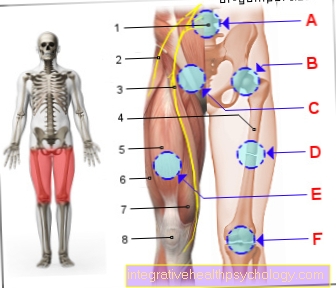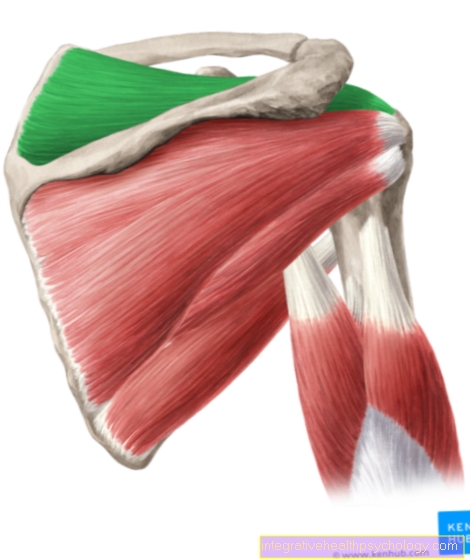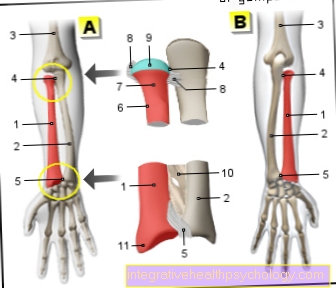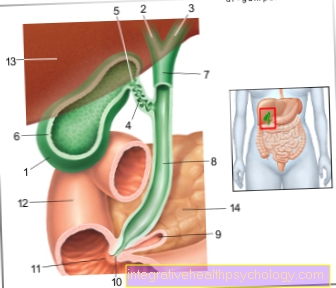enema
definition
An enema is the introduction of liquid through the anus into the intestine. The terms anal flushing or enema, which are derived from the Greek word for cleansing, are used synonymously. Enemas are prescribed by a doctor and different types of enemas are used depending on the requirement.

preparation
In preparation for an enema, you should find a suitable place for the administration, depending on whether you are doing it yourself or being treated in the hospital / practice. Most commonly, enemas take place in bed, on the bathroom floor, or in the bathtub. A suitable mat should lie underneath you for any leaks and overflows. Most enemas will be performed at body temperature or 37-40.5 ° C. The solution and the accessories should be prepared according to the product and package insert.
procedure
The enema can be done by a doctor, a nurse, or by yourself. If you do the enema yourself, you have to be careful never to force the tube into the anus, otherwise the intestine could be injured. It is best to lie down during the process, as the procedure can stress the circulation. If you do the enema on yourself, you often use the knee-elbow position: you crouch on the floor and support yourself on your knees and with one elbow. The second hand inserts the intestinal tube into the anus.
If an enema is used for the enema, the tip of the enema is inserted with a little lubricant and finally the entire enema is inserted into the rectum while twisting. The sphincter has to be relaxed. The liquid is then slowly pushed from the bag into the tube and introduced into the intestine. Then the patient should contract the sphincter and the nurse or person performing the procedure removes the tube. After about 10 minutes, the patient is allowed to empty the bowel normally in the toilet.
In the case of an intestinal enema, the nurse warms water to body temperature. An enema is usually used to empty the bowels or clear stubborn blockages, which is why the fluid must be introduced further up the digestive tract. Therefore, you use an intestinal tube of the desired length, put lubricant on it and insert it 10 to 20 centimeters deep into the intestine with gentle turning movements. Liquid is given into the intestine through a tube in the tube. It is important that the patient breathes with their mouth open and that the abdominal muscles are not tensed. Once the fluid has been introduced, the patient should contract the sphincter muscle and the intestinal tube removed.
A liquid at body temperature is also used for colonic irrigation, for example 5,000 milliliters in adults. The caregiver prepares an intestinal tube coated with lubricant, which in this case has a feeding and a discharging tube. The patient relaxes the sphincter muscle and the nurse introduces the intestinal tube into the intestine by twisting movements and lets fluid run in. The process is repeated until finally clear liquid runs through the draining hose. The tube is then clamped off and the intestinal tube is carefully removed while the sphincter is tense.
In the case of enemas before the birth, miniature animals are often used, the contents of which are injected into the rectum. Meanwhile, you sit on the toilet and quickly feel the pressure to empty. You can also have the enema performed in bed by a nurse or midwife with warm water.
Side effects
Enemas can lead to side effects and risks, which is why they should only be performed by trained personnel. In rare cases, the bowel may be punctured or torn from excessive stretching. Circulatory disorders can develop in the intestinal wall, which are very dangerous if left untreated. Scalding can result if the rinsing solution is too hot. Electrolyte disturbances, infection or circulatory problems can occur.
Duration
The actual enema only takes a few minutes. An agreed time is then set with the nursing staff to try to suppress the bowel movement. Often people are asked to hold stool for 10 to 20 minutes. Then you can go to the toilet as normal.
Indications
Doctors will prescribe different types of enemas, depending on the urination requirements. The simple enema is used particularly often. An enema helps with acute constipation or prior to diagnostic interventions in the anus area, as the bowel movement occurs very quickly. There are so-called orthograde colonic irrigation, also called cleansing enemas, which are used to clean the colon before colonoscopy or abdominal surgery. There are different variants of orthograde colonoscopies: irrigations, high enemas, lifting or swiveling enemas and rectal colonic irrigation.
In addition, there are special enemas that are helpful in hospitals for various clinical pictures, such as lactulose enemas, which are used in cirrhosis of the liver. Resonium enemas are chosen for patients who have too much potassium in their blood (hyperkalemia). Special medicated enemas can be the treatment of choice for diseases such as inflammatory ulcerative colitis, a chronic inflammation of the large intestine.
In paediatrics, so-called "rectal instillations" with saline solution are administered when the intestinal wall becomes invaded, which acts like an intestinal obstruction. Alternative medicine practitioners use colonic irrigation in the form of a subaqual colonic bath to cleanse the bowel.
Before birth
An enema before birth means that the bowel is emptied in a targeted manner before birth. This helps many women to go into labor unrestrainedly and to press. There is less to fear that the intestinal contents will be squeezed out during a severe contraction. Another advantage of an enema before the birth is that there is more space in the small pelvis for the child's head. In addition, many women cramp if they accidentally press stool while pressing. This increases the sensation of pain and extends the child's expulsion phase. In addition, an enema also promotes labor. You can decide for yourself whether you want an enema before the birth or not.
When constipated
A common reason for an enema is constipation. Enemas are preferably used, which can be bought for single or multiple use in the pharmacy or can be carried out by a nurse with appropriate single-use preparations. A solution of glycerine and water is often used. After the solution has entered the rectum, the patient should try to hold back the stool for 10-20 minutes. Then the chair can be emptied in the toilet. An enema helps to cleanse the bowel and loosen the blockages if you are constipated.
What might also interest you: Constipation- What Can You Do About It?
For colon cleansing
Colon cleansing by means of an enema requires that sufficient filtered water is fed into the bowel and stimulates bowel movement so that the entire bowel can be cleaned and not just the rectal intestinal areas. As soon as enough water is passed into the intestines, it is excreted in the toilet. The process is repeated until the liquid is clear. Usually three enemas are made. Gently massaging the abdomen can help to aid bowel movement. If you want, you can add therapeutic substances for the third enema, for example olive oil, peppermint oil or aloe vera.
How often do you need an enema?
The question of how often you need an enema is often questioned critically. Theoretically, regular bowel movements are a completely natural way of cleansing the body's colon. In addition, part of the intestinal bacteria, the so-called intestinal flora, is washed out when the colon is cleansed. Therefore, the intestinal flora has to regenerate and rebuild the flora after each enema. If there is a health reason to rehabilitate the bowel, an enema is undoubtedly indicated. In conventional medicine, enemas are only carried out if there are causes for complaints, such as constipation or the emptying of the intestinal contents during childbirth. Alternative medicine and naturopaths recommend more frequent enemas for colon cleansing, for example in connection with a fasting cure.
additive
with oil
Many alternative medicine practitioners assume that adding oil to the enema fluid will help remove old "waste products" from the intestines. It is recommended to add a little olive oil or peppermint oil to the water for the solution. The liquid is then heated and can be used for the enema.
with pear
There are different enemas for colon cleansing enemas that have different structures and shapes. Often, pear-tipped enemas are used. The "pears" have different volume sizes. Pear-tipped enemas are very easy to use and can be used very well for your own implementation. Enemas are available in pharmacies.
with baking soda
Soda (sodium hydrogen carbonate) is often referred to colloquially as baking soda, baking soda or baking soda. The main goal of a soda enema is to cleanse the intestines of accumulated toxins, debris, feces and stones. The enema with soda is very good for repeated enemas, for example if you suffer from constipation over a long period of time. You can buy the baking soda in the pharmacy and add it to the rinsing liquid for the enema. It is essential to adhere to the dosage instructions for the active ingredient. Otherwise, overdosing the rinsing liquid with soda can lead to irritation of the intestinal mucosa. As a rule, a dissolution of about 20 to 30 grams of baking soda in 800 milliliters of water is recommended. Usually 2 liters of liquid is prepared for an enema and the mixture is heated to a temperature of 38 to 42 ° C.





























